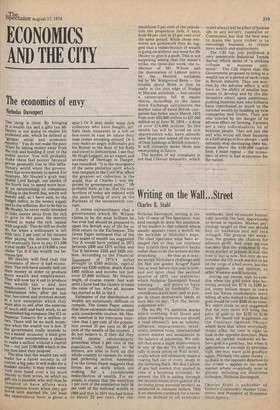Writing on the Wall...Street
Charles R. Stahl
Nicholas Davenport, writing in the July 13 issue of The Spectator, was kind enough to draw the attention of his readers to this column which usually appears twice a month on the backside of Nicholas's page. The chief Spectator must have arranged this so that our columns may scratch their respective backs rather than to let the writers do the scratching. . . . Be that as it may, we accept Nicholas's challenge and bet him one golden Kruger Rand that at least before this year is over, and not later than the second quarter of 1975, our statement which Nicholas Davenport found wanting . . . will prove to have been justified by hindsight. The countdown starts now, and as poeple in those democratic lands of ours like to say, "Let the better judgement win . . . ." .
The six iffy 'I's, question marks which overhang Wall Street and other investing canyons (or should it read abysses?), are as follows: inflation, impeachment, insolvency, interest rates, international money market and imbalances in the balance of payments. We submit that even a slight improvement in any of the six Ts will cause a rally in stock prices on Wall Street, a rally which will ultimately make a roaring bull out of every sheep in the investing flock. We don't know of any bull market that started in time of a booming economy. At present the US is sailing through the second consecutive quarter of a declining gross national product as measured in constant dollars. This is an absolute yardstick for a recession as defined in all economic textbooks. And recessions historically provide the best opportunity to invest in equities. Market psychology taught us that one should buy on weakness and sell into strength. The greater the weakness, the greater the chances for ultimate profit. And since no one can deny that the weakness in the stock market at present is real, the time to buy is now. Not only do we consider the US stock market to be on the verge of a bull move, but the same applies, in our opinion, to other Western world bourses.
During our recent visit to London when the gold price was hovering around the $170 to $180 level, every bullion dealer in town and his Swiss confederate were telling all who wished to listen that gold would be over $200 in no time. We didn't think so and suggested that the next move will bring the price of gold to the $125 to $130 area. We based our suggestion on the Contrary Opinion Theory which says that when everybody thinks alike, the time is right to look in the opposite direction. Nota bene, on current weakness we believe gold is a good buy, but when it approaches or exceeds its previous high, one may wave gold goodbye again. Precisely the same theory — to think in the opposite direction to the crowd — applies to the stock market where everybody now is gloomy, including our illustrious colleague, Nicholas Davenport.
Oharles Stahl is publisher of Green's Commodity Market Comments and President of Economic News Agency.


































 Previous page
Previous page